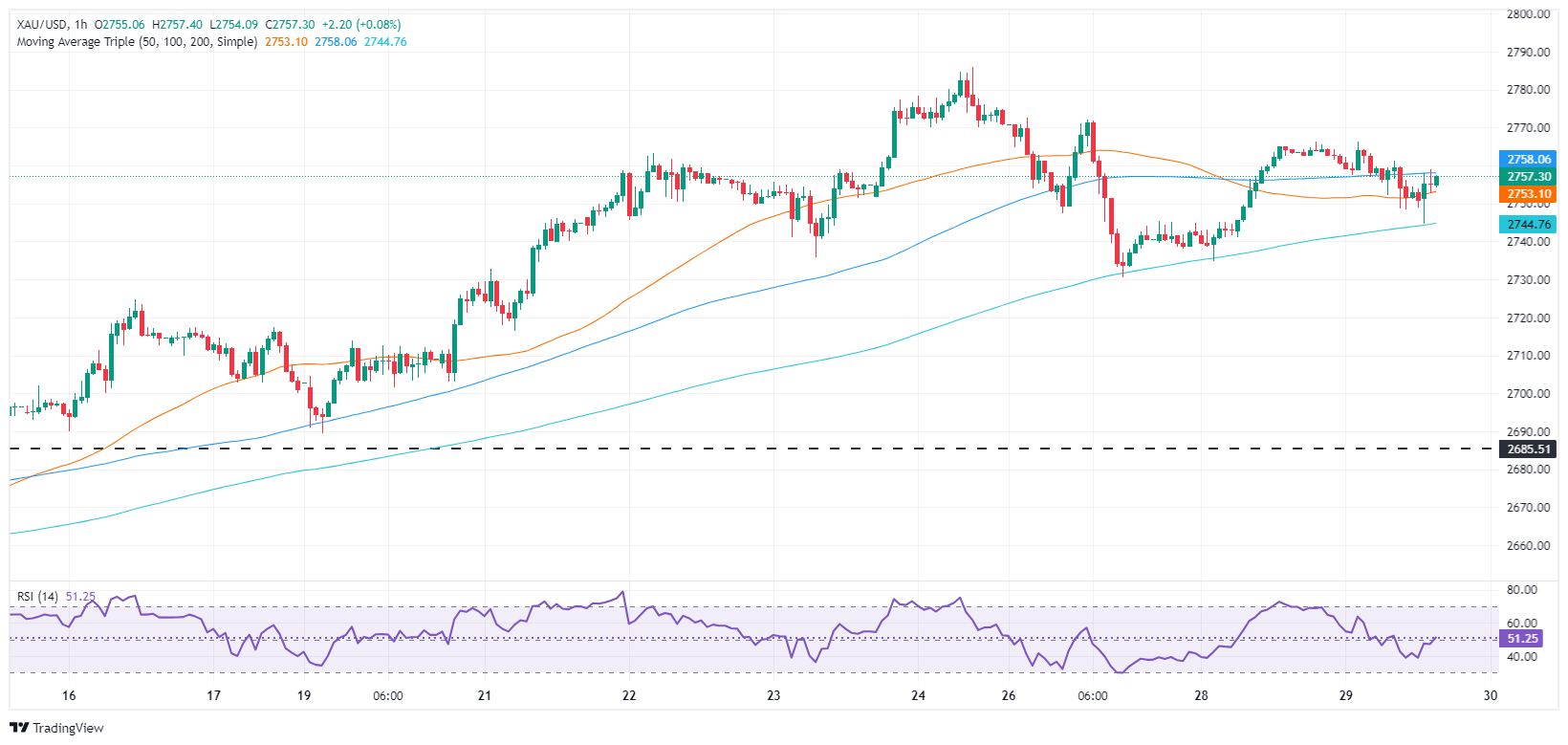Gold prices wobble as Fed maintains hawkish stance on policy
- Gold prices show modest reaction to Fed's rate hold, hinting at future rate hike pauses.
- Fed Chair Powell adopts patient stance on policy, influenced by changing fiscal and trade environments.
- Investors focus on Powell's insights for future Fed actions, anticipating upcoming economic data.
Gold prices edged lower as the US Federal Reserve (Fed) delivered a hawkish hold. The Fed removed inflation language, an indication of a pivot towards maintaining rates unchanged. The XAU/USD trades volatile within the $2,750 - $2,740 range as Fed Chair Jerome Powell crossed the wires.
Powell’s first question was about having been contacted by US President Donald Trump. He answered he had not spoken with Trump and firmly stated that he wouldn’t comment on Trump’s policies or politics.
In addition, Powell said that monetary policy is “less restrictive than it had been,” adding that the Fed is not in a rush to adjust rates. He added that the Federal Open Market Committee (FOMC) is in wait-and-see mode, eyeing fiscal and trade policies implemented by the new US administration.
Powell clarified the Fed doesn’t have a pre-set course on setting interest rates, and when asked about the March meeting, he said they’re not in a rush.
Given the backdrop, XAU/USD seesawed, yet it remains near $2,750 modestly lower. After the Fed’s decision, traders are eyeing the release of Gross Domestic Product (GDP) figures, jobs data, and the Fed’s preferred inflation gauge, the Core Personal Consumption Expenditures (PCE) Price Index.
Daily digest market movers: Gold price losses ground after Powell’s press conference
- Earlier, the Federal Reserve unanimously decided to hold rates unchanged at the 4.25% - 4.50% range and dropped inflation language, which traders perceived as indicating that the Fed would keep rates higher for longer.
- The statement added that the economy is expanding solidly, the unemployment rate has stabilized, and labor market conditions remain solid. Additionally, it added that it remained focused on both sides of the dual mandate.
- The Fed's decision was unanimous.
- The US 10-year Treasury yield rises one basis point up to 4.549% and caps Gold’s advance.
- The US Dollar Index (DXY), which tracks the buck’s value against a basket of six currencies, climbs 0.12%, up at 108.04, a headwind for Bullion.
- Given the backdrop, Gold prices extended their losses, yet they were quite moderate as traders await Fed Chair Jerome Powell's press conference.
- The CME FedWatch Tool shows that investors expect 50 basis points of easing through 2025, with the first-rate cut seen in June.
XAU/USD technical outlook: Gold’s uptrend intact, as XAU/SD hovers near $2,750
Gold price uptrend remains intact even though the yellow metal dips slightly following the Fed’s decision. XAU/USD hit a daily low of $2,744, trimming some of its earlier losses, and it seems poised to form a ‘bullish harami’ candle pattern, which suggests that higher prices are expected.
In that outcome, XAU/USD next resistance would be the January 24 high at $2,785. A breach of the latter will expose the record high at $2,790, followed by $2,800.
Conversely, if Gold extends its losses and drops below $2,750, the next support would be the $2,730, the January 27 swing low. A breach of the latter will expose $2,700.
Gold FAQs
Gold has played a key role in human’s history as it has been widely used as a store of value and medium of exchange. Currently, apart from its shine and usage for jewelry, the precious metal is widely seen as a safe-haven asset, meaning that it is considered a good investment during turbulent times. Gold is also widely seen as a hedge against inflation and against depreciating currencies as it doesn’t rely on any specific issuer or government.
Central banks are the biggest Gold holders. In their aim to support their currencies in turbulent times, central banks tend to diversify their reserves and buy Gold to improve the perceived strength of the economy and the currency. High Gold reserves can be a source of trust for a country’s solvency. Central banks added 1,136 tonnes of Gold worth around $70 billion to their reserves in 2022, according to data from the World Gold Council. This is the highest yearly purchase since records began. Central banks from emerging economies such as China, India and Turkey are quickly increasing their Gold reserves.
Gold has an inverse correlation with the US Dollar and US Treasuries, which are both major reserve and safe-haven assets. When the Dollar depreciates, Gold tends to rise, enabling investors and central banks to diversify their assets in turbulent times. Gold is also inversely correlated with risk assets. A rally in the stock market tends to weaken Gold price, while sell-offs in riskier markets tend to favor the precious metal.
The price can move due to a wide range of factors. Geopolitical instability or fears of a deep recession can quickly make Gold price escalate due to its safe-haven status. As a yield-less asset, Gold tends to rise with lower interest rates, while higher cost of money usually weighs down on the yellow metal. Still, most moves depend on how the US Dollar (USD) behaves as the asset is priced in dollars (XAU/USD). A strong Dollar tends to keep the price of Gold controlled, whereas a weaker Dollar is likely to push Gold prices up.



